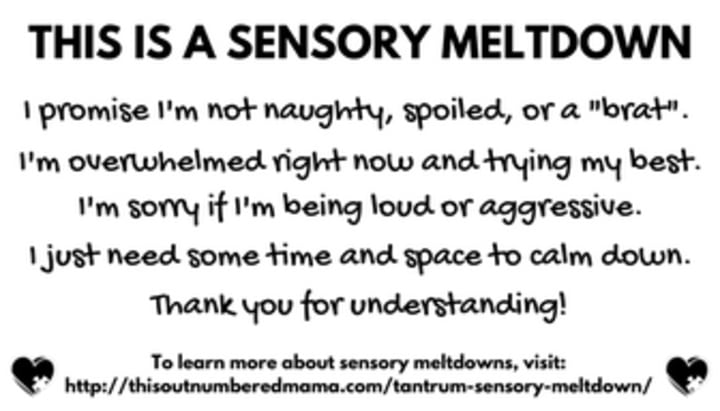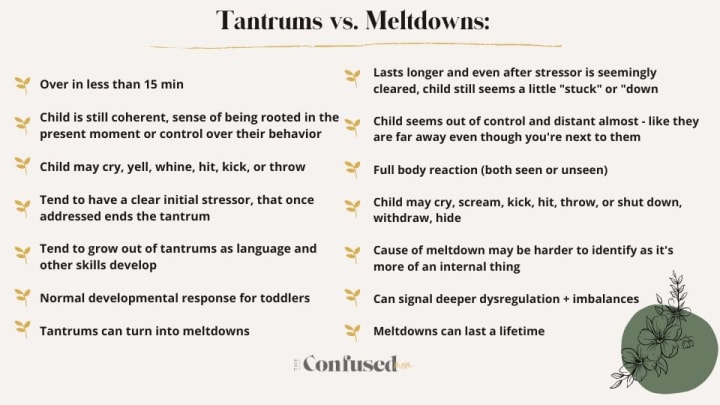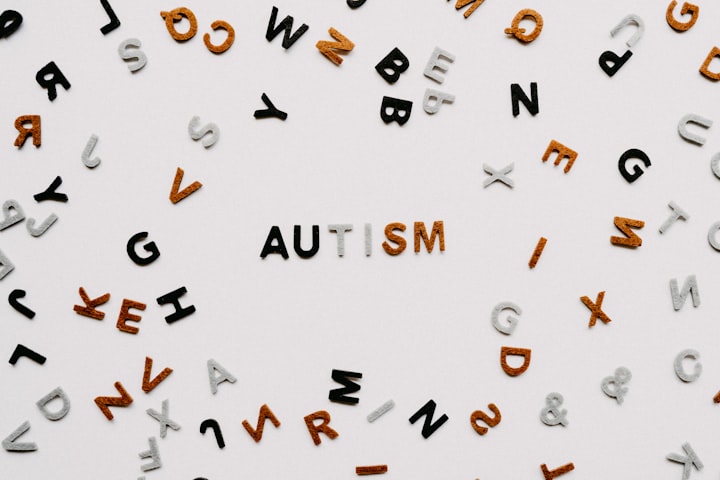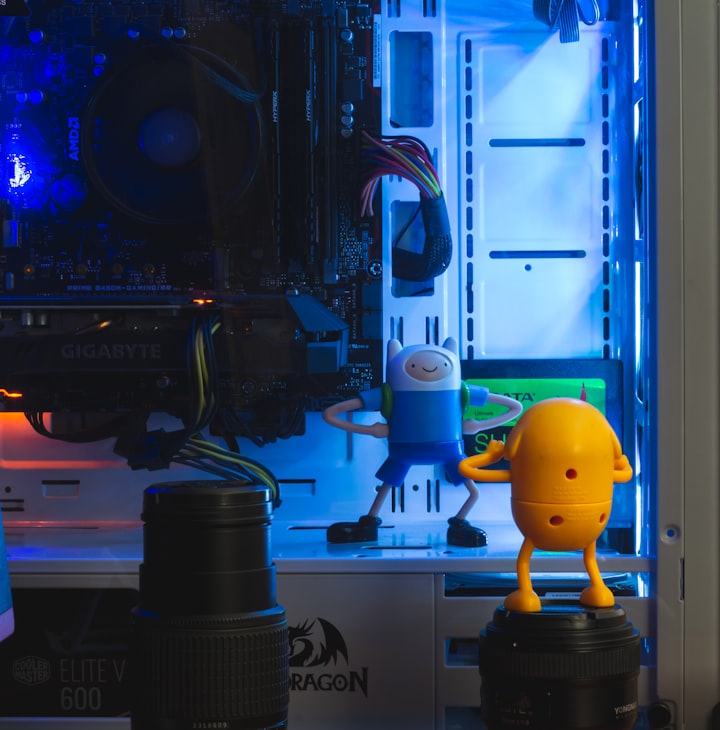An autistic meltdown is not a temper tantrum
What's the difference, and how can you be helpful?

April is World Autism Month - a month to increase understanding of autism spectrum disorder, and work together to end the stigma and discrimination that many autistic people face. In Canada, an estimated one of fifty youth have been diagnosed with autism. It's important to remember that autism is a spectrum disorder. This means that individual needs vary among those living with it, and no two autistic people are the same. Where one person might show competency in verbal communication, another may rely on communication devices such as apps or drawings.
Despite the vast differences in its presentation, one thing remains fairly consistent among autistic individuals: meltdowns. Often, those who aren't familiar with autism become frustrated by meltdowns, assuming those who experience them to be misbehaving or naughty. Many label this behaviour as tantrum-like before fully understanding its root causes - and, as an autistic adult who often has meltdowns, I'm tired of this misconception. There are similarities, of course. There are also many differences, and I think it's important to learn how to differentiate: not only to judge a behaviour for what it is, but to understand how to best de-escalate and support.
What is a tantrum? What is a meltdown?
Although sensory meltdowns are frequent among autistic children and adults, they're not exclusive to those with autism. Many neurodivergent individuals have experienced meltdowns and the stigma that comes with them, especially as an adult. They're an uncontrolled response to sensory overload or over-stimulation: an overwhelming situation that slowly pushes you over the edge. During a meltdown, we become unaware, controlled by an overwhelming response to strong emotion. Because of the dysregulation that accompanies a meltdown, those in the midst of one may accidentally hurt themselves or others.
There is no goal: no motivation, no ulterior motive. There is just a loss of control that comes with the inability to communicate or escape. A meltdown does not end voluntarily. It is consuming, resolved only by time and the decrease of whatever sensory overload triggered it. Afterwards, it's not uncommon to feel exhausted or embarrassed - specifically if the meltdown happened in a public place, or as an adult. Unlike the tantrum phase, they're not something we outgrow.
Tantrums are common among young children (and even some adults)! They're an intentional and controlled reaction to fulfill a need or want. There is a motivation behind a tantrum: people have a tantrum to achieve a goal, as opposed to an involuntary reaction to a trigger. There is still a sense of self-awareness and purpose, but there's also an inability to communicate or a feeling of being misunderstood. Particularly in young children, strong emotions can be difficult to understood or communicate, and this is frustrating.
Generally, a person having a tantrum is in control of their actions, and aware of their surroundings. Although some help may be needed to regain control and regulate emotions, people end tantrums of their own will after either accomplishing their original goal or realizing that a tantrum won't end in their favour. Once external motivation is lost, the tantrum will end.

How can you tell the difference?
Although meltdowns and tantrums are different, both signal a need, an inability to communicate, and a feeling of being misunderstood. For those on the outside, they look very similar: a full-body reaction to a stimuli, resulting in bad behaviour such as kicking, screaming, or hitting. When it comes to distinguishing between the two, the most important thing to remember is that tantrums are goal-oriented, purposeful behaviour, and meltdowns are an uncontrolled response to sensory overload.
At first glance, of course, it can be difficult to determine whether a behaviour is related to a meltdown or a tantrum. During a tantrum, a person is likely to pay attention to their surroundings, react to the reactions of other people, try to bargain or compromise, and eventually stop the behaviour by choice. During a meltdown, a person is likely to shut down or try to escape, lose their ability to problem solve or communicate, and fail to respond to the reactions of other people, or when spoken to. Another important thing to remember is that tantrums are self-motivated. While a meltdown often leads to self-injury due to loss of control, a person having a tantrum has enough control of their body to prevent injury.
To help determine whether someone is having a tantrum or a meltdown, you can speak to them. During a tantrum, you are likely to get a response. During a meltdown, you are not. Observe to see whether the person is in danger of injuring themselves or others. It's important to try and differentiate because there are more efficient ways to deal with each behaviour, and understanding the behaviour makes it easier to resolve it.
Understanding Behaviour: Finding a Resolution
It's hard to know exactly how to deal with miscommunications or unpleasant behaviour. Regardless of the reason behind the outburst, it helps to practice patience (even though I know this isn't always easy)! Dealing with a small child having a tantrum is exhausting, but there are some ways to help ease the outburst and eventually stop it altogether.
01. Acknowledge and validate the person's feelings.
Children have tantrums because they're overwhelmed, and struggle to regulate their emotions. Try to help put a name to the feeling so that you can help them understand and work through it.
02. Stay calm.
Try to resist the urge to shout or scold the child, as this will add to their stress and likely make the tantrum worse. It may help to remember that they're still learning how to verbalize and process emotions.
03. Offer distractions or choices.
Often, tantrums can be reduced by redirecting the child's attention. This can be done by offering a toy or activity that they like, distracting them from their tantrum, and placing their attention and energy onto something they enjoy.
04. Don't give in to demands.
This teaches the child that they can get their way by throwing a tantrum or acting out for attention.
05. Withhold attention.
Unless the behaviour is harmful to themselves or others, consider ignoring it as best you can. If the child doesn't get the attention they're looking for, their behaviour may stop.
‗‗‗‗‗‗‗‗‗‗‗‗‗‗‗‗‗‗‗‗‗‗‗‗‗‗‗‗‗‗‗‗‗‗‗‗‗‗
Being the parent of a neurodivergent child - or being neurodivergent yourself - can be frustrating. As an adult who has had public meltdowns, I know firsthand how embarrassing and disorienting they can be. From an outsider's perspective, it's easy to judge this behaviour. If we don't understand the reason behind a behaviour, i's easy to label it as childish or attention-seeking. Understanding meltdowns and the triggers that lead to them is the first step in understanding how to help support a person dealing with them.
01. Don't yell at, grab, or scold the person.
It's overwhelming: both for the person in the midst of a meltdown, and for anyone watching. Because a meltdown is a result of over-stimulation, adding sensory input to the situation will likely only make a meltdown worse.
02. Don't ask questions or demand explanations.
In order to decrease sensory overwhelm, it's crucial to remember that communication is limited during a meltdown. Although the person can understand you, it's likely that they are incapable of communication. This will likely add to the frustration of having a meltdown in the first place, and could escalate the behaviour.
03. Make sure the environment is safe. Check for any possible sensory triggers that may have contributed to the meltdown.
When a person goes into a meltdown stage, they are unable to judge danger in their environment, which makes it easy for them to unintentionally injure themselves. You can help by moving things out of the way or gently guide them away from something that may lead to injury.
04. Have comfort items on hand.
Most autistic people have comfort items that help with emotional regulation. This can include things like stuffed animals, noise-cancelling headphones, sensory toys, or a weighted blanket. Having these items nearby can be soothing and familiar, thereby reducing the duration or severity of a meltdown.
05. Remain as patient and calm as possible, and speak in a soothing voice.
Many autistic and neurodivergent people are sensitive to the negative emotions of others. This is why it's so important to be aware of our emotions when supporting someone in a meltdown.

Sources
https://www.theconfusedmillennial.com/tantrum-vs-meltdown/
https://www.verywellhealth.com/how-to-calm-a-child-with-autism-4177696
https://www.thearticulateautistic.com/navigating-autistic-meltdowns-a-dos-and-donts-guide/
https://psychcentral.com/stress/temper-tantrums#dealing-with-tantrums
About the Creator
ghostsandrebels
i'm a a queer writer, poet, cat lover, and author. i'm passionate about psychology, human rights, and creating places where lgbt+ youth and young adults feel safe, represented, and supported.
29 | m.
follow me on threads for more.
Reader insights
Outstanding
Excellent work. Looking forward to reading more!
Top insights
Easy to read and follow
Well-structured & engaging content
Expert insights and opinions
Arguments were carefully researched and presented
Eye opening
Niche topic & fresh perspectives
Heartfelt and relatable
The story invoked strong personal emotions
On-point and relevant
Writing reflected the title & theme






Comments (3)
Interesting. Great work. I wrote a piece on autism too!
This is the all-important info: When it comes to distinguishing between the two, the most important thing to remember is that tantrums are goal-oriented, purposeful behavior, and meltdowns are an uncontrolled response to sensory overload. Nice article!
Insightful and helpful. Thank you for posting. I think you might have a typo in the first #4 in the text. I suspect you mean to say ‘will not’ as opposed to will? Again, important content. Will be sharing as broadly as I can.